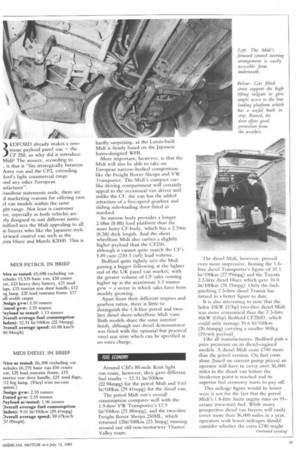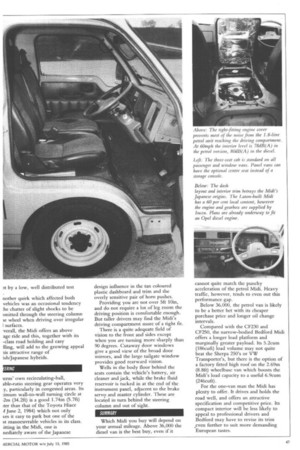MIDI DOUBLE TAKE
Page 46

Page 47

Page 48

Page 49

If you've noticed an error in this article please click here to report it so we can fix it.
Once they have mastered the knack of entering the rather cramped cab of Bedford's recently introduced Midi panel van, drivers will probably like its car-like comfort, easy handling and smooth ride. Operators, too, may be impressed by features such as its standard side loading door and payload which even marginally exceeds that of its big brother, the CF. . .
3 EDFORD already makes a onetonne payload panel van the CF 250, so why did it introduce Midi? The answer, according to , is that it "fits strategically between Astra van and the CF2, extending ford's light commercial range and any other European
mfacturer".
rrandiose statements aside, there arc d marketing reasons for offering two cl van models within the same ght range. Not least is customer ice, especially as both vehicles are rly designed to suit different tastes. ledford sees the Midi appealing to all se buyers who like the Japanese style brward control van such as the (ota Hiace and Mazda E2000. This is hardly surprising, as the Luton-built Midi is firmly based on the Japanese Isuzu-designed WFR.
More important, however, is that the Midi will also be able to take on European narrow-bodied competition like the Freight Rover Sherpa and VW Transporter. The Midi's compact carlike driving compartment will certainly appeal to the occasional van driver and, unlike the CF, the van has the added attraction of a five-speed gearbox and sliding side-loading door fitted as standard.
Its narrow body provides a longer 2.68m (8.8ft) load platform than the more boxy CI= body, which has a 2.54m (8.3ft) deck length. And the short wheelbase Midi also carries a slightly higher payload than the CF250, although it cannot quite match the CF's 5.89 cutn (210.3 cult) load volume.
Bedford quite rightly sees the Midi gaining a bigger following at the lighter end of the UK panel van market, with the greater volume of CF sales coming higher up at the maximum 3.5 tonnes gvw a sector in which sales have been steadily growing.
Apart from their different engines and gearbox ratios, there is little to distinguish the 1.8-litre petrol and twolitre diesel short-wheelbase Midi vans. Both models share the same interior finish, although our diesel demonstrator was fitted with the optional but practical vinyl seat trim which can be specified at no extra charge.
FUEL ECONOMY Around CM's 85-mile Kent light van route, however, they gave different fuel results 12_31 lit/100km (22.94mpg) for the petrol Midi and 9.61 lit/100km (29.41mpg) for the diesel van.
The petrol Midi van's overall consumption compares well with the 1.9-litre VW Transporter's 12.9 lit/100km (21.88mpg), and the two-litre Freight Rover Sherpa 250HL, which returned 121it/100kni (23.5mpg) running around our old notimotorway Thames Valley route. The diesel Midi, however, proved even more impressive, beating the 1.6litre diesel Transporter's figure of 10.1 lit/100km (27.99mpg) and the Toyota 2.2-litre diesel Hiace which gave 10.0 lit/1(X)km (28.15mpg). Only the fuelpinching 2.5-litre diesel Transit has turned in a better figure to date.
It is also interesting to note that the laden 43kW (57hp) two-litre diesel Midi was more economical than the 2.3-litre 46kW (61hp) Bedford CF250D, which could only manage 10.6 lit/100km (26.66mpg) carrying a smaller 965kg (19cwt) payload.
Like all manufacturers, Bedford puts a price premium on its diesel-engined models. A diesel Midi costs .£740 more than the petrol version. On fuel costs alone (based on current pump prices) an operator will have to cover over 36,000 miles in the diesel van before the breakeven point is reached and its superior fuel economy starts to pay off.
This mileage figure would be lower were it not for the fact that the petrol Midi's 1.8-litre Isuzu engine runs on 91octane (two-star) fuel. While many prospective diesel van buyers will easily cover more than 36,000 miles in a year, operators with lower mileages should consider whether the extra £740 might give a better return invested elsewhere. The shorter oil change interval, 3,000 miles compared with the petrol vans 9,000 miles, must also be taken into account.
For all its economy the lsuzu diesel engine gives the laden Midi a rather indifferent performance compared with its more powerful petrol-engined twin. Climbing the long M20 bank on our test route the diesel van took a full 30 seconds more to reach the summit, and its overall average speed of 59.6km/h (37.09mph) was noticeably slower than the petrol Midi's 65.8km/h (40.94mph).
CAB ACCESS Access to the Midi's driving compartment is made awkward by the van's forward control design — a criticism we also levelled at the VW Transporter. To make matters worse Bedford fits a small step in front of the wheelarch to encourage a face-on entry, which resulted on more than one occasion in heads striking the roof By far the best method of entry is to ignore the step — which would be better removed altogether — grab the A-post handle and slide in sideways.
The Midi's high-back seats proved comfortable enough even after a long journey, although a little more support at the base of the backrest could be added.
All instruments are well laid out in the main binnacle and easily seen through the small steering wheel. The column-mounted gear lever has a light, slick action and a well defined pattern, although the spring detent towards third and fourth ratios could be stronger. The cab heater fan on in the diesel van, though, was poor. Even when fully on output was very low.
The typically-Japanese umbrella-type handbrake caused its own problems. When retracted, the handle sits close to the facia making it possible to catch a thumb on the sharp edge of the dash when turning the handle to release the ratchet.
Despite this the park brake functioned well, holding securely on a 25 per cent (1 in 4) slope and releasing cleanly to allow a restart on the same gradient. Bedford specifies 250mm (9.8in) ventilated discs for the Midi's front brakes, slightly smaller than those on CF2 models. The rears are the same 254mm (10in) diameter drums.
Overall the Midi brakes proved superb during our track tests of full pressure stops at speeds of up to 64krr (40mpb).
Parts of our light van route provide road surfaces that are not far removed from proving-ground conditions with potholes, ramps and bad cambers. These sections quickly revealed the ful capabilities of the Midi's suspension with its independently-sprung front er The combination of double wishbor arms, coil springs and double-acting telescopic dampers with a stabiliser bal to reduce body roll, tended to provide fairly soft ride; almost too soft when travelling along undulating surfaces, a! slight pitching could develop.
The rear end with its four-leaf semielliptic springs and telescopic dampers felt quite firm too, but this was aided at by a low, well distributed test nother quirk which affected both vehicles was an occasional tendency he chatter of slight shocks to be smitted through the steering column se wheel when driving over irregular surfaces.
verall, the Midi offers an above age ride and this, together with its -class road holding and easy fling, will add to the growing appeal ais attractive range of ish/Japanese hybrids.
ERIE uzus' own recirculating-ball, able-ratio steering gear operates very y, particularly in congested areas. Its :imum wall-to-wall turning circle at .2m (34.2(t) is a good 1.74m (5.7ft) :ter than that of the Toyota Hiace 4 June 2, 1984) which not only Providing you are not over 5ft 10in, and do not require a lot of leg room the driving position is comfortable enough. But taller drivers may find the Midi's driving compartment more of a tight fit. There is a quite adequate field of vision to the front and sides except when you are turning more sharply than 90 degrees. Cutaway door windows give a good view of the broad door mirrors, and the large tailgate window provides good rearward vision. Wells in the body floor behind the seats contain the vehicle's battery, air cleaner and jack, while the brake fluid reservoir is tucked in at the end of the instrument panel, adjacent to the brake servo and master cylinder_ These are located in turn behind the steering column and out of sight. MANY Which Midi you buy will depend on your annual mileage. Above 36,000 the diesel van is the best buy, even if it cannot quite match the punchy acceleration of the petrol Midi. Heavy traffic, however, tends to even out this performance gap. Below 36,000, the petrol van is likely to be a better bet with its cheaper purchase price and longer oil change intervals. Compared with the CF230 and CF250, the narrow-bodied Bedford Midi offers a longer load platform and marginally greater payload. Its 5.2cum (186cuft) load volume may not quite beat the Sherpa 250's or VW Transporter's, but there is the option of a factory fitted high roof on the 2.69m (8.8ft) wheelbase van which boosts the Midi's load capacity to a useful 6.9cum (246cuft). For the one-van man the Midi has plenty to offer. It drives and holds the road well, and offers an attractive specification and competitive price. Its compact interior will be less likely to appeal to professional drivers and Bedford may have to revise its trim even further to suit more demanding European tastes.Tags




















































































